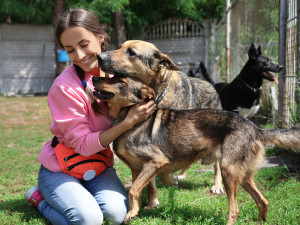How to Become a Dog Trainer
This guide will help you turn your dog training passion into a profession.
You want to become a dog trainer because you love dogs, right? Makes sense. But before you take the plunge into the career of your dreams, ask yourself this very important question: How do you feel about people? Most of dog training requires teaching people. Sure, you could land a job training service dogs or dogs living in shelters, but the vast majority of dog trainers earn a living by teaching classes and private lessons for pet parents. And the success of a dog’s training program depends upon the human’s compliance with that program. Still interested? Read on to learn how to become a dog trainer.
What is a dog trainer?
While we all know that a good dog trainer can help turn a wild hound into a well-behaved pup, they’re also so much more. Dog trainers guide and support pet parents, helping them understand their pet’s needs and develop a strong bond with their pup. A good dog trainer should be able to interpret a dog’s body language. They can decode a dog’s barks, wiggles, and tail wags to figure out what they’re trying to tell us. By understanding what the dog is trying to convey, dog trainers can provide insight into a dog’s quirks and how to train them more effectively.
Save on the litter with color-changing tech that helps you better care for your cat.
How to become a dog trainer? Step by Step
There are many routes one might take to gain the skills and experience required to train other people’s dogs. Many trainers are self-taught, relying on books, videos, and personal experience for their education. Others learn by apprenticing with an established trainer or choose a more formal route by attending an academy for dog trainers. But the best dog trainers explore all paths and recognize that the journey never ends. Here’s a step-by-step guide to help you become a dog trainer.
Step 1: Gather Educational Resources
When people catch the dog training bug — often as a result of working with their own difficult dog or taking an inspiring group class — their first step down the path to becoming a professional dog trainer is to study the many articles, books, and videos on the subject of animal behavior and training.
How much do you spend on your pet per year?
Books
In order to effectively train dogs, you need to know how to read and understand canine body language. Every dog training library should begin with Canine Body Language: A Photographic Guideopens in new tab by Brenda Aloff. Other must-reads include Don’t Shoot the Dog by Karen Pryoropens in new tab; Culture Clash by Jean Donaldsonopens in new tab; Excel-Erated Learning by Pamela Reidopens in new tab; The Other End of the Leash by Patricia McConnellopens in new tab; and Complete Idiot’s Guide to Positive Dog Training by Pamela Dennisonopens in new tab.
Seminars
Conferences, seminars, and workshops are fantastic sources of knowledge as well as great networking opportunities. From one- or two-hour evening seminars to weeklong conferences, there are enough educational events across the country to keep a trainer learning, meeting, and greeting all year long. The biggest get-togethers for dog trainers — and anyone interested in dog training — are ClickerExpo and the Association of Pet Dog Trainers(APDT) conference.
Step 2: Gain Dog Training Experience
Of course, self-education can take you only so far. At a certain point, in order to learn how to train a dog, you need to get hands-on dog-training practice from someone with more experience. While this can take many forms, what better way than with a mentor? Some dog-training academies include formal dog-training apprenticeships as part of their programs. Some dog trainers offer internships through their own businesses. And sometimes, an informal apprenticeship grows out of a dog trainer/client relationship.
Jill Dextrase, co-owner of Sit Happensopens in new tab!, in Calgary, Alberta, Canada, met her mentor when she enrolled her own problem dog in a group class at the local humane society. After apprenticing for several years with the instructor, Jill took over her mentor’s business and now teaches classes and private lessons out of her own facility.
Volunteering at an animal shelter is another excellent way to gain hands-on experience with a wide variety of dogs. Many shelters now have training programs in which volunteers are instructed on how to train dogs so that they become more adoptable. This can be as simple as teaching a dog to wait at doorways or as complex as behavior modification for reactive or fearful dogs. If your local shelter doesn’t have a training program, volunteering to establish one, once you’re qualified, is a terrific way to gain client referrals from the shelter staff and other volunteers.
Step 3: Earn a Dog Trainer Certification
The next step to beginning your professional dog trainer career is to earn a training certificate. There is no government regulation of dog trainers in the United States, but there are a number of dog-trainer schools and organizations through which you can earn credentials. Be diligent when researching schools; many proclaim themselves to be “positive” and “humane” while promoting techniques and equipment that are quite the opposite.
Certification Council for Professional Dog Trainers
The most well-known dog trainer certifications are from the Certification Council for Professional Dog Trainers (CCPDT), which offers the Certified Professional Dog Trainer — Knowledge Assessedopens in new tab (CPDT-KA) and Certified Professional Dog Trainer — Knowledge and Skills Assessedopens in new tab (CPDT-KSA). Earning a CPDT-KA isn’t a cakewalk, but you’ll learn a lot along the way and your clients will understand that you are committed to a high level of learning. While the tests take only a few hours, meeting the requirements to pass the certification test could take months or years. Certification requirements for the CPDT-KSA include video submission of assigned training exercises, hands-on exercises, and an exam. They also offer the Certified Behavior Consultant Canine-Knowledge Assessed (CBCC-KA) certification, which is a more rigorous test.
Note: Not a dog-trainer school but a certification test
Setting: Remote exam and video submission
Length: You’ll need 300 hours of dog-training experience
Test cost: $400+
Academy for Dog Trainers
Jean Donaldson, founder and former director of the SF/SPCA Academy, created the Academy for Dog Trainersopens in new tab. This dog trainer course takes the form of lectures and training demonstrations, self-assessment tools, and virtual classrooms. Students work at their own pace with their own dogs in their own homes. The Academy has intensive video coaching that requires students to submit videos of their behavior training, which coaches review and provide detailed feedback. Graduation from this dog trainer class requires written exams and a video review. Earning a CTC (Certificate in Training and Counseling) certification at this dog training school takes two years.
Length: Two-year dog-trainer program
Setting: Work from home because it’s completely remote
Dog trainer course cost: $8,225
Karen Pryor Academy
The Karen Pryor Academyopens in new tab (KPA) also offers the convenience of distance learning, but combines it with four-weekend workshops with the instructor and fellow classmates. KPA instructors are extremely well regarded in the industry and are located across the U.S. and internationally; students may choose the instructor they want to work with. The curriculum is entirely online and includes training exercises and interim tests. One unique feature of the KPA curriculum is the requirement to train an animal of a species other than a dog. Graduation requirements include an online final exam and in-person teaching and training assessments.
Length: Six-month dog-trainer program
Setting: Virtual with a mix of in-person training
Dog trainer course cost: $5,600
What are career opportunities for dog trainers?
So, you’ve decided to become a dog trainer, and now you’re wondering what’s next? There are several career opportunities for dog trainers.
Private dog trainer
Group class instructor
Service dog trainer
Shelter dog trainer
Dog sitter
Dog walker
Dog training writer
Canine adoption counselor
Canine sports and agility instructor
Detection dog handler
Boarding kennel owner
If training dogs professionally interests you but you’re not sure about making the transition from whatever you’re doing now, take just one simple step toward your goal, and then take another: Read a book. Watch a video. Complete a class. If the bug catches you, you’ll know it, and you won’t be able to stop the momentum. And whatever you do, even after you’ve been training dogs for 30 years, don’t stop learning and improving your dog training skills. You can never know too much about dogs, and the world and its dogs need as many great trainers as they can get.
FAQs on How to Become a Dog Trainer
How long does it take to become a dog trainer?
Becoming a certified dog trainer can take a few months to a few years, depending on the dog trainer certification program.
How much does it cost to be a dog trainer?
The cost to become a certified dog trainer ranges from $400 to $8000, depending on the school and the desired certifications.
What qualifications do I need to be a dog trainer?
There are no formal qualifications to become a dog trainer, but certification is recommended. Certification may require hundreds of hours of dog-training experience, exams, and coaching.






